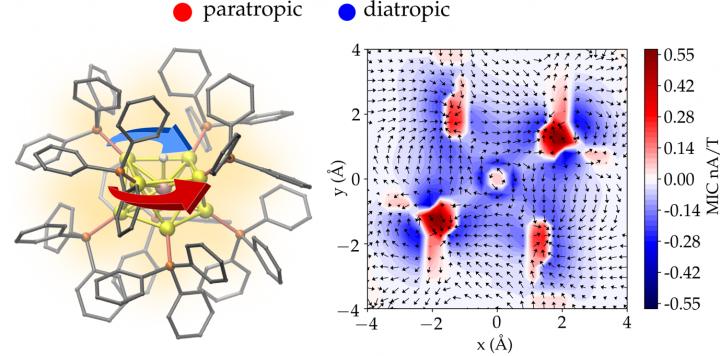Researchers analyzed circulating currents inside gold nanoparticles

The atomic structure of a gold nanoparticle protected by phosphine molecules (left) and magnetic-field-induced electron currents in a plane intersecting the center of the particle (right). The total electron current consists of two (paratropic and diatropic) components circulating in opposite directions.
Credit: University of Jyväskylä/Omar Lopez Estrada
A new method facilitates accurate analysis of magnetic field effects inside complex nanostructures.
Researchers in the Nanoscience Center of University of Jyvaskyla, in Finland and in the Guadalajara University in Mexico developed a method that allows for simulation and visualization of magnetic-field-induced electron currents inside gold nanoparticles. The method facilitates accurate analysis of magnetic field effects inside complex nanostructures in nuclear magnetic resonance measurements and establishes quantitative criteria for aromaticity of nanoparticles. The work was published 30.4.2021 as an Open Access article in Nature Communications.
According to the classical electromagnetism, a charged particle moving in an external magnetic field experiences a force that makes the particle’s path circular. This basic law of physics is used, e.g., in designing cyclotrons that work as particle accelerators. When nanometer-size metal particles are placed in a magnetic field, the field induces a circulating electron current inside the particle. The circulating current in turn creates an internal magnetic field that opposes the external field. This physical effect is called magnetic shielding.
The strength of the shielding can be investigated by using nuclear magnetic resonance (NMR) spectroscopy. The internal magnetic shielding varies strongly in an atomic length scale even inside a nanometer-size particle. Understanding these atom-scale variations is possible only by employing quantum mechanical theory of the electronic properties of each atom making the nanoparticle.
Now, the research group of Professor Hannu Häkkinen in the University of Jyväskylä, in collaboration with University of Guadalajara in Mexico, developed a method to compute, visualize, and analyze the circulating electron currents inside complex 3D nanostructures. The method was applied to gold nanoparticles with a diameter of only about one nanometer. The calculations shed light onto unexplained experimental results from previous NMR measurements in the literature regarding how magnetic shielding inside the particle changes when one gold atom is replaced by one platinum atom.
A new quantitative measure to characterize aromaticity inside metal nanoparticles was also developed based on the total integrated strength of the shielding electron current.
“Aromaticity of molecules is one of the oldest concepts in chemistry, and it has been traditionally connected to ring-like organic molecules and to their delocalized valence electron density that can develop circulating currents in an external magnetic field. However, generally accepted quantitative criteria for the degree of aromaticity have been lacking. Our method yields now a new tool to study and analyze electron currents at the resolution of one atom inside any nanostructure, in principle. The peer reviewers of our work considered this as a significant advancement in the field”, says Professor Häkkinen who coordinated the research.
###
The authors of the article included post-doctoral researcher Omar Lopez Estrada (lead author), PhD student Elli Selenius and university researcher Sami Malola in Häkkinen’s group and professor Bernardo Zuniga-Gutierrez in Guadalaraja University in Mexico. The computations were made by using the Finnish Computing Competence Infrastructure (FCCI) in University of Jyväskylä.
Link to the research in Nature Communications in 30 April 2021
Further information: Professor Hannu Häkkinen, hannu.j.hakkinen@jyu.fi, tel. +358 400 247 973
All latest news from the category: Physics and Astronomy
This area deals with the fundamental laws and building blocks of nature and how they interact, the properties and the behavior of matter, and research into space and time and their structures.
innovations-report provides in-depth reports and articles on subjects such as astrophysics, laser technologies, nuclear, quantum, particle and solid-state physics, nanotechnologies, planetary research and findings (Mars, Venus) and developments related to the Hubble Telescope.
Newest articles

First-of-its-kind study uses remote sensing to monitor plastic debris in rivers and lakes
Remote sensing creates a cost-effective solution to monitoring plastic pollution. A first-of-its-kind study from researchers at the University of Minnesota Twin Cities shows how remote sensing can help monitor and…

Laser-based artificial neuron mimics nerve cell functions at lightning speed
With a processing speed a billion times faster than nature, chip-based laser neuron could help advance AI tasks such as pattern recognition and sequence prediction. Researchers have developed a laser-based…

Optimising the processing of plastic waste
Just one look in the yellow bin reveals a colourful jumble of different types of plastic. However, the purer and more uniform plastic waste is, the easier it is to…


